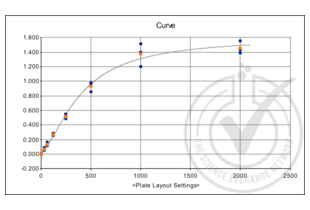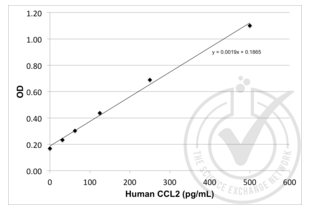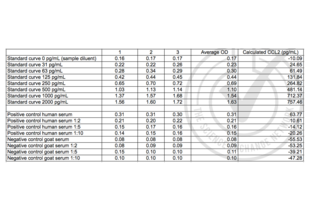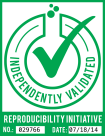CCL2 ELISA Kit
-
- Target Alle CCL2 ELISA Kits anzeigen
- CCL2 (Chemokine (C-C Motif) Ligand 2 (CCL2))
-
Reaktivität
- Human
- Nachweismethode
- Colorimetric
- Methodentyp
- Sandwich ELISA
- Detektionsbereich
- 31.25-2000 pg/mL
- Untere Nachweisgrenze
- 31.25 pg/mL
- Applikation
- ELISA
- Verwendungszweck
- For the quantitative determination of human monocyte chemotactic protein 1/monocyte chemotactic and activating factor (MCP-1/MCAF) concentrations in serum, plasma, urine, saliva, cell culture supernates, cerebrospinal fluid (CSF), ascitic fluid, tissue homogenates.
- Proben
- Cell Culture Supernatant, Cerebrospinal Fluid, Plasma, Saliva, Serum, Tissue Homogenate, Urine
- Analytische Methode
- Quantitative
- Spezifität
- This assay has high sensitivity and excellent specificity for detection of human MCP-1/MCAF.
- Kreuzreaktivität (Details)
- Limited by current skills and knowledge, it is impossible for us to complete the cross-reactivity detection between the target antigen and all analogues for other species. Therefore, cross reaction may still exist.
- Sensitivität
- 30.184 pg/mL
- Bestandteile
-
- Assay plate (12 × 8 coated Microwells)
- Standard (freeze dried)
- Biotin-antibody (100 × concentrate)
- HRP-avidin (100 × concentrate)
- Biotin-antibody Diluent
- HRP-avidin Diluent
- Sample Diluent
- Wash Buffer (25 × concentrate)
- TMB Substrate
- Stop Solution
- Adhesive Strip (for 96 wells)
- Instruction manual
-
-
- Applikationshinweise
-
- The supplier is only responsible for the kit itself, but not for the samples consumed during the assay. The user should calculate the possible amount of the samples used in the whole test. Please reserve sufficient samples in advance.
- Samples to be used within 5 days may be stored at 2-8°C, otherwise samples must be stored at -20°C (≤ 1 month) or -80°C (≤ 2 months) to avoid loss of bioactivity and contamination.
- Grossly hemolyzed samples are not suitable for use in this assay.
- If the samples are not indicated in the manual, a preliminary experiment to determine the validity of the kit is necessary.
- Please predict the concentration before assaying. If values for these are not within the range of the standard curve, users must determine the optimal sample dilutions for their particular experiments.
- Tissue or cell extraction samples prepared by chemical lysis buffer may cause unexpected ELISA results due to the impacts of certain chemicals.
- Owing to the possibility of mismatching between antigens from another resource and antibodies used in this supplier's kits (e.g., antibody targets conformational epitope rather than linear epitope), some native or recombinant proteins from other manufacturers may not be recognized by this supplier's products.
- Influenced by factors including cell viability, cell number and cell sampling time, samples from cell culture supernatant may not be recognized by the kit.
- Fresh samples without long time storage are recommended for the test. Otherwise, protein degradation and denaturalization may occur in those samples and finally lead to wrong results.
- Kommentare
-
Detection wavelength: 450 nm
Information on standard material:
Depending on the antigen to be detected, standards can be either native or recombinant protein. The recombinant proteins are being expressed in CHO cells in most cases. Please inquire for more information. The formulation of auxiliary material in the standard is considered proprietary information, however it does not contain any poisonous substance. Proclin 300 (1:3000) is used as preservative.
Information on reagents:
In most cases the stop solution provided is 1 N H2SO4. The formulation of wash solution is proprietary information. None of the components contain (sodium) azide, thimerosal, 2-mercaptoethanol (2-ME) or any other poisonous materials. For the sandwich method kits, the sample diluent, antibody diluent, enzyme diluent and standard all contain BSA.
Information on antibodies:
The antibodies provided in different kits vary in regards to clonality and host. Some antibodies are affinity purified, some are Protein A - Probenmenge
- 100 μL
- Testdauer
- 1 - 4.5 h
- Plattentyp
- Pre-coated
- Protokoll
- This assay employs the quantitative sandwich enzyme immunoassay technique. Antibody specific for MCP-1/MCAF has been pre-coated onto a microplate. Standards and samples are pipetted into the wells and any MCP-1/MCAF present is bound by the immobilized antibody. After removing any unbound substances, a biotin-conjugated antibody specific for MCP-1/MCAF is added to the wells. After washing, avidin conjugated Horseradish Peroxidase (HRP) is added to the wells. Following a wash to remove any unbound avidin-enzyme reagent, a substrate solution is added to the wells and color develops in proportion to the amount of MCP-1/MCAF bound in the initial step. The color development is stopped and the intensity of the color is measured.
- Aufbereitung der Reagenzien
-
- Biotin-antibody (1×) - Centrifuge the vial before opening.
Biotin-antibody requires a 100-fold dilution. The suggested dilution is 10µL of Biotin-antibody + 990µL of Biotin-antibody Diluent. - HRP-avidin (1×) - Centrifuge the vial before opening.
HRP-avidin requires a 100-fold dilution. The suggested dilution is 10µL of HRP-avidin + 990µL of HRP-avidin Diluent. - Wash Buffer (1×) - If crystals have formed in the concentrate, warm up to room temperature and mix gently until the crystals have completely dissolved. Dilute 20mL of Wash Buffer Concentrate (25×) into deionized or distilled water to prepare 500mL of Wash Buffer (1×).
- Standard - Centrifuge the standard vial at 6000-10000rpm for 30s.
Reconstitute the Standard with 1ml of Sample Diluent. Do not substitute other diluents. This reconstitution produces a stock solution of 200pg/mL. Mix the standard to ensure complete reconstitution and allow the standard to sit for a minimum of 15 minutes with gentle agitation prior to making dilutions.
Pipette 250µL of Sample Diluent into each tube. Use the stock solution to produce a 2-fold dilution series. Mix each tube thoroughly before the next transfer. The undiluted Standard serves as the high standard (200pg/mL). Sample Diluent serves as the zero standard (0ng/mL).
- Kindly use graduated containers to prepare the reagent. Please don't prepare the reagent directly in the Diluent vials provided in the kit.
- Bring all reagents to room temperature (18-25°C) before use for 30 min.
- Prepare fresh standard for each assay. Use within 4 hours and discard after use.
- Making serial dilution in the wells directly is not permitted.
- Please carefully reconstitute Standards according to the instruction. Avoid foaming and mix gently until the crystals have completely dissolved. To minimize imprecision caused by pipetting, use small volumes and ensure that pipettors are calibrated. It is recommended to suck more than 10µL when pipetting.
- It is recommended to use distilled water to prepare reagents and samples. Using contaminated water or container for reagent preparation will influence detection result.
- Biotin-antibody (1×) - Centrifuge the vial before opening.
- Testpräzision
-
Intra-assay precision (precision within an assay): Three samples of known concentration were tested twenty times on one plate to assess precision.
Inter-assay precision (precision between assays): Three samples of known concentration were tested in twenty assays to assess precision.- Intra-assay: CV% less than 8%
- Inter-assay: CV% less than 10%
- Beschränkungen
- Nur für Forschungszwecke einsetzbar
-
- by
- CGIBD Advanced Analytics Core
- No.
- #029766
- Datum
- 18.07.2014
- Antigen
- Chargennummer
- Z02184065
- Validierte Anwendung
- ELISA
- Positivkontrolle
- Human serum - expression is ~16 pg/mL
- Negativkontrolle
- Goat serum (non-reactive species)
- Bewertung
- Target protein was detected in the positive control sample and not in the negative control sample as expected.
- Primärantikörper
- Sekundärantikörper
- Full Protocol
- 1. All reagents were brought up to room temperature for 30 minutes prior to use. The 1x Wash Buffer was prepared by adding 20 mL of 25x Wash Buffer Concentrate to 480 mL of distilled/deionized water and mixing thoroughly.
- 2. The vial of Standard was reconstituted with 1 mL of Sample Diluent, mixed, and allowed to sit for 15 minutes with gentle agitation.
- 3. The standard curve was prepared by creating a 2-fold dilution series of seven standards (including the original undiluted vial) using Sample Diluent. Sample Diluent alone served as the 0 pg/mL standard.
- 4. The assay plate was removed from the foil pouch and 100 μL of each standard and sample were added to the appropriate wells, in triplicate. The plate was covered with the adhesive strip provided and incubated for 2 hours at 37 °C.
- 5. Approximately 10 minutes before the incubation ended, a 1x Biotin-antibody solution was prepared by diluting 60 μL of 100x Biotin-antibody into 5940 μL of Biotin-antibody Diluent.
- 6. The liquid from each well was removed.
- 7. 100 μL of 1x Biotin-antibody solution was added to each well, and the plate was covered with a new adhesive strip, and incubated for 1 hour at 37 °C.
- 8. Approximately 10 minutes before the incubation ended, a 1x HRP-avidin solution was prepared by diluting 60 μL of 100x HRP-avidin into 5940 μL of HRP-avidin Diluent.
- 9. Each well was aspirated and washed, repeating the process two times for a total of three washes. Each well was washed by filling each well with 1x Wash Buffer and letting it stand for 2 minutes. After the last wash, remaining Wash Buffer was removed and the plate was inverted and blotted against clean, absorbent paper towels.
- 10. 100 μL of 1x HRP-avidin solution was added to each well, the plate was covered with a new adhesive strip, and incubated for 1 hour at 37 °C.
- 11. The aspiration/wash procedure from Step 9 was repeated for an additional 5 washes.
- 12. 90 μL of TMB Substrate was added to each well. The plate was protected from light and incubated for 15-30 minutes at 37 °C, with periodic checking to prevent overdevelopment.
- 13. 50 μL of Stop Solution was added to each well and mixed thoroughly. The optical density (OD) of each well was measured within 5 minutes using a microplate reader set to 450 nm.
- 14. A standard curve was generated by plotting the OD value for each standard on the y-axis against the concentration on the x-axis using Excel. A line of best fit through the points on the graph was used to generate the equation x = (y-0.1865) / 0.0019.
- 15. The equation was used to calculate CCL2 concentrations of the samples based on their average OD values.
- Anmerkungen
- At high concentrations the readout of the assay is non-linear.
Validierung #029766 (ELISA)![Erfolgreich validiert 'Independent Validation' Siegel]()
![Erfolgreich validiert 'Independent Validation' Siegel]() Validierungsbilder
Validierungsbilder![Figure 2: Table of absorbance readings (OD 450 nm) for standard curve, positive (human serum) and negative (goat serum) control samples. Value for Average Reading is derived from the average of three readings (OD 450nm). An equation x = (y-0.1865) / 0.0019 was generated from the partial standard curve (in the linear range) and used to calculate CCL2 concentrations shown in the Table.]() Figure 2: Table of absorbance readings (OD 450 nm) for standard curve, positive (human serum) and negative (goat serum) control samples. Value for Average Reading is derived from the average of three readings (OD 450nm). An equation x = (y-0.1865) / 0.0019 was generated from the partial standard curve (in the linear range) and used to calculate CCL2 concentrations shown in the Table.
Protokoll
Figure 2: Table of absorbance readings (OD 450 nm) for standard curve, positive (human serum) and negative (goat serum) control samples. Value for Average Reading is derived from the average of three readings (OD 450nm). An equation x = (y-0.1865) / 0.0019 was generated from the partial standard curve (in the linear range) and used to calculate CCL2 concentrations shown in the Table.
Protokoll -
- Vorsichtsmaßnahmen
- The Stop Solution provided with this kit is an acid solution. Wear eye, hand, face and clothing protection when using this material.
- Handhabung
-
- The kit should not be used beyond the expiration date on the kit label.
- Do not mix or substitute reagents with those from other lots or sources.
- If samples generate values higher than the highest standard, dilute the samples with Sample Diluent and repeat the assay.
- Any variation in Sample Diluent, operator, pipetting technique, washing technique, incubation time/temperature and kit age can cause variation in binding.
- This assay is designed to eliminate interference by soluble receptors, binding proteins and other factors present in biological samples. Until all factors have been tested in the Immunoassay, the possibility of interference cannot be excluded.
- Lagerung
- 4 °C/-20 °C
- Informationen zur Lagerung
- For unopened kit: All the reagents should be kept according to the labels on vials.
- Haltbarkeit
- 6 months
-
-
: "Functional Role of SUV39H1 in Human Renal Tubular Epithelial Cells Under High-glucose Ambiance." in: Inflammation, Vol. 41, Issue 1, pp. 1-10, (2018) (PubMed).
: "The role of mononuclear cell tissue factor and inflammatory cytokines in patients with chronic thromboembolic pulmonary hypertension." in: Journal of thrombosis and thrombolysis, Vol. 42, Issue 1, pp. 38-45, (2017) (PubMed).
: "RELATIONSHIP OF ADIPOKINES AND PROINFLAMMATORY CYTOKINES AMONG ASIAN INDIANS WITH OBESITY AND YOUTH ONSET TYPE 2 DIABETES." in: Endocrine practice : official journal of the American College of Endocrinology and the American Association of Clinical Endocrinologists, Vol. 21, Issue 10, pp. 1143-51, (2015) (PubMed).
: "Lactoferrin suppresses the Epstein-Barr virus-induced inflammatory response by interfering with pattern recognition of TLR2 and TLR9." in: Laboratory investigation; a journal of technical methods and pathology, Vol. 94, Issue 11, pp. 1188-99, (2014) (PubMed).
: "The peritoneal leptin, MCP-1 and TNF-? in the pathogenesis of endometriosis-associated infertility." in: American journal of reproductive immunology (New York, N.Y. : 1989), Vol. 65, Issue 4, pp. 403-6, (2011) (PubMed).
-
: "Functional Role of SUV39H1 in Human Renal Tubular Epithelial Cells Under High-glucose Ambiance." in: Inflammation, Vol. 41, Issue 1, pp. 1-10, (2018) (PubMed).
-
- Target Alle CCL2 ELISA Kits anzeigen
- CCL2 (Chemokine (C-C Motif) Ligand 2 (CCL2))
- Andere Bezeichnung
- Monocyte chemotactic protein 1/monocyte chemotactic and activating factor (MCP-1/MCAF) (CCL2 Produkte)
- Hintergrund
- Synonyms: GDCF-2, HC11, HSMCR30, MCAF, MCP-1, MCP1, MGC9434, SCYA2, SMC-CF, monocyte chemoattractant protein-1|monocyte chemotactic and activating factor|monocyte secretory protein JE|small inducible cytokine
- HGNC
- 10618
- UniProt
- P13500
- Pathways
- Cellular Response to Molecule of Bacterial Origin, Positive Regulation of Immune Effector Process, ER-Nucleus Signaling, Unfolded Protein Response, Phosphorylierungen bei SARS-CoV-2 Infektion
-




 (5 Referenzen)
(5 Referenzen) (1 Validierung)
(1 Validierung)



